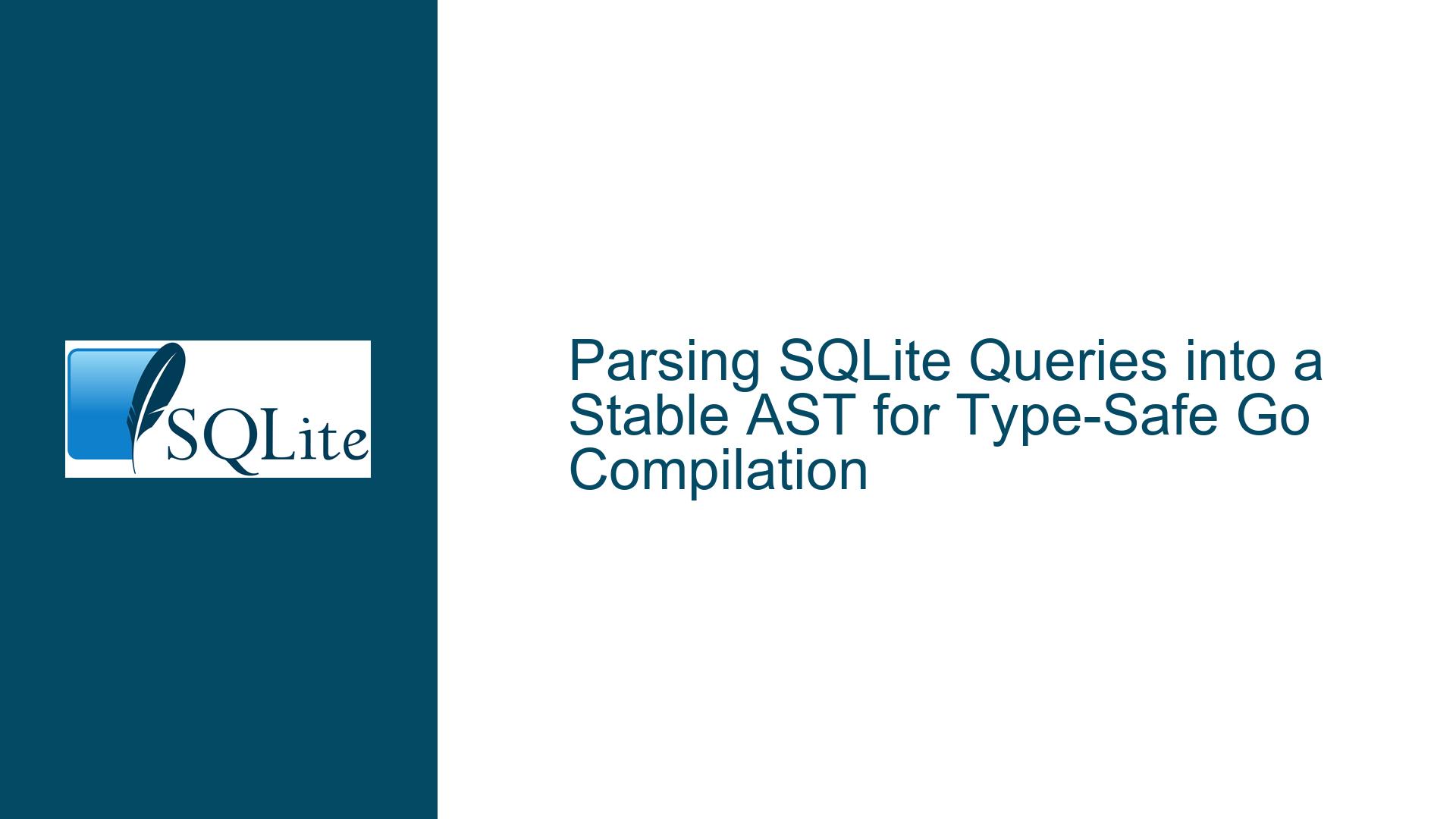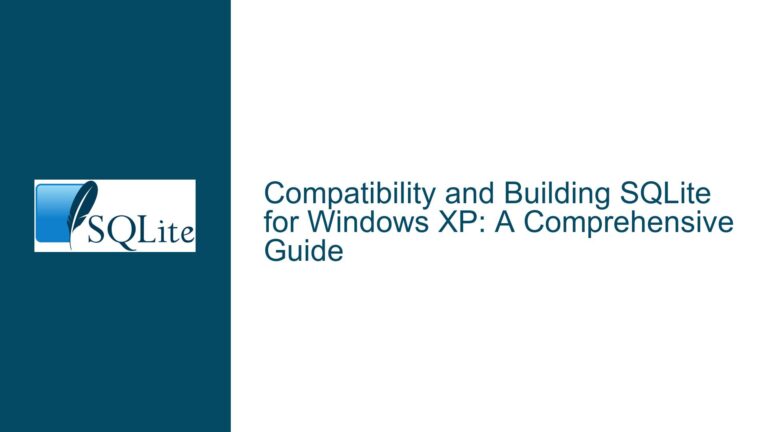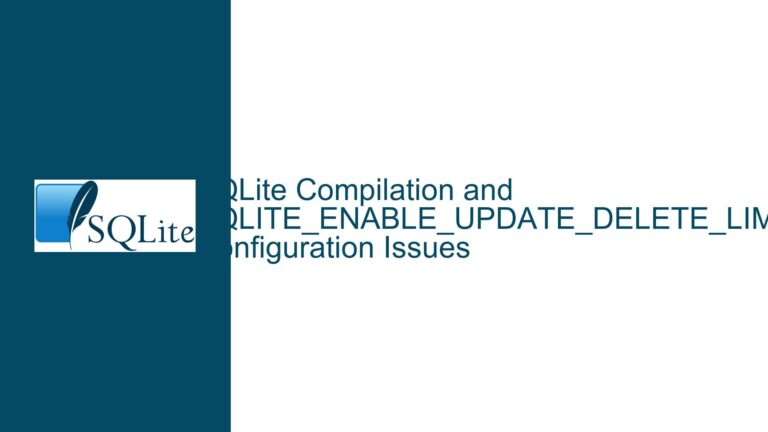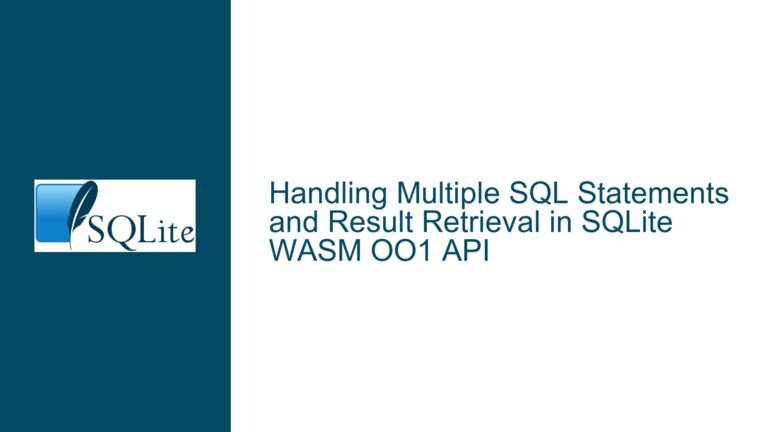Parsing SQLite Queries into a Stable AST for Type-Safe Go Compilation
SQLite Query Parsing and AST Generation Challenges
The core issue revolves around the difficulty of parsing SQLite queries into a stable Abstract Syntax Tree (AST) for use in type-safe Go compilation, particularly for non-SELECT statements such as INSERT, DELETE, UPDATE, CREATE, and DROP. While SQLite generates a full AST for SELECT statements, it does not do so for other types of queries. Additionally, the AST structure for SELECT statements is subject to frequent changes, making it unsuitable as a stable API for external tools like sqlc. This poses a significant challenge for developers aiming to leverage SQLite’s query parsing capabilities in a way that is both robust and future-proof.
The problem is further compounded by the need to maintain compatibility with SQLite’s internal development cycle. SQLite’s AST is not designed as a public API, and its structure evolves to meet the database engine’s internal requirements. This makes it difficult to rely on the AST for external tooling without risking breakage or instability. Developers seeking to parse SQLite queries into a structured format must therefore explore alternative approaches that balance stability, flexibility, and compatibility with SQLite’s internal architecture.
Limitations of SQLite’s Internal AST and External Parsing Needs
One of the primary causes of this issue is the inherent design of SQLite’s internal AST. The AST is primarily intended for use within the SQLite engine itself, and its structure is optimized for performance and internal consistency rather than external consumption. This means that the AST is not exposed as a public API, and its structure can change between SQLite versions as the engine evolves. For developers looking to parse SQLite queries into a stable format, this presents a significant obstacle.
Another contributing factor is the lack of a standardized, stable parsing interface for SQLite queries. While tools like Lemon (the parser generator used by SQLite) are highly effective for generating parsers, they do not provide a built-in mechanism for producing a stable AST that can be used outside of SQLite. This forces developers to either rely on the internal AST (with its associated risks) or implement their own parsing logic, which can be error-prone and difficult to maintain.
The need for type-safe Go compilation adds another layer of complexity. Tools like sqlc require a structured representation of SQL queries to generate type-safe Go code. However, the lack of a stable AST for non-SELECT statements makes it difficult to achieve this goal. Developers must therefore find a way to parse SQLite queries into a structured format that is both stable and compatible with the requirements of type-safe Go compilation.
Strategies for Stable SQLite Query Parsing and AST Generation
To address these challenges, developers can explore several strategies for parsing SQLite queries into a stable AST. One approach is to use SQLite’s own parsing logic as a foundation, while isolating the resulting AST from changes in the SQLite codebase. This can be achieved by creating a wrapper around SQLite’s parser that produces a stable, version-independent AST. The wrapper would need to handle differences in the internal AST structure between SQLite versions, ensuring that the external AST remains consistent regardless of changes in the underlying code.
Another approach is to implement a custom parser for SQLite queries that produces a stable AST. This parser could be based on the SQLite grammar, but would be designed specifically for external use. By decoupling the parser from SQLite’s internal architecture, developers can ensure that the AST remains stable and compatible with external tools like sqlc. However, this approach requires a deep understanding of SQLite’s grammar and parsing logic, and may involve significant development effort.
A third option is to leverage existing libraries or tools that provide SQLite query parsing capabilities. For example, some SQLite wrappers or ORMs include parsers that can be adapted for use in generating a stable AST. While these tools may not provide a complete solution out of the box, they can serve as a starting point for developing a custom parsing solution. Developers should carefully evaluate the stability and compatibility of these tools before integrating them into their workflow.
In addition to these strategies, developers should consider the use of intermediate representations (IRs) to bridge the gap between SQLite’s internal AST and the requirements of type-safe Go compilation. An IR is a structured representation of a query that is independent of the underlying database engine. By converting SQLite queries into an IR, developers can achieve a stable and consistent representation that can be used for code generation. This approach requires the development of a translation layer between SQLite’s AST and the IR, but can provide a robust solution for long-term compatibility.
Finally, developers should engage with the SQLite community to explore potential improvements to the parsing and AST generation process. By contributing to the development of SQLite or related tools, developers can help shape the future of SQLite query parsing and ensure that it meets the needs of external tooling. This may involve proposing changes to SQLite’s internal architecture, developing new parsing libraries, or collaborating with other developers to create a standardized parsing interface.
In conclusion, parsing SQLite queries into a stable AST for type-safe Go compilation is a complex but solvable problem. By understanding the limitations of SQLite’s internal AST, exploring alternative parsing strategies, and leveraging intermediate representations, developers can achieve a robust and future-proof solution. While the process requires careful planning and development effort, the resulting benefits in terms of stability, compatibility, and type safety make it a worthwhile investment.






